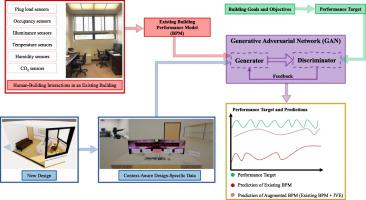当前位置:
X-MOL 学术
›
Autom. Constr.
›
论文详情
Our official English website, www.x-mol.net, welcomes your
feedback! (Note: you will need to create a separate account there.)
Augmenting building performance predictions during design using generative adversarial networks and immersive virtual environments
Automation in Construction ( IF 9.6 ) Pub Date : 2020-11-01 , DOI: 10.1016/j.autcon.2020.103350 Chanachok Chokwitthaya , Yimin Zhu , Supratik Mukhopadhyay , Edward Collier
Automation in Construction ( IF 9.6 ) Pub Date : 2020-11-01 , DOI: 10.1016/j.autcon.2020.103350 Chanachok Chokwitthaya , Yimin Zhu , Supratik Mukhopadhyay , Edward Collier

|
Abstract Existing building performance models (existing BPMs) often lack the capability for addressing human-building interactions in future buildings or buildings under design because they are mainly derived using data in existing buildings. The limitation may contribute to discrepancies between simulated and actual building performance. In a previous study, the authors discussed a framework using an artificial neural network (ANN)-based greedy algorithm which combines context-aware design-specific data obtained from immersive virtual environments (IVEs) with an existing BPM to enhance the simulations of human-building interactions in new designs. Although the framework has revealed the potential to improve simulations, it cannot determine the appropriate combination between context-aware design-specific data and the existing BPM. In this paper, the authors present a new computational framework (the GAN-based framework) to determine an appropriate combination based on a given performance target to achieve. Generative adversarial networks (GANs) are used to combine data of an existing BPM and context-aware design-specific data using a performance target as a guide to produce an augmented BPM. The effectiveness and the reliability of the GAN-based framework were validated using an IVE of a single occupancy office. Thirty people participated in an experiment on the simulation of artificial lighting switch uses using the IVE. Their light switch uses data under different work area illuminance were collected and analyzed. The building performance models (BPMs) proposed by Hunt and Da Silva were selected as the existing BPM and the performance target respectively. The data of each participant was used to generate an augmented BPM using the GAN-based framework and an updated BPM using the previous framework (i.e., ANN-based greedy algorithm framework). The thirty pairs of the augmented and updated BPMs were compared. Specifically, the errors measured between the updated BPMs and the performance target (E1) and the errors measured between the augmented BPMs and the performance target (E2) were analyzed using t-tests (α = 0.05). In 22 out of 30 cases, the performance of the augmented BPMs was significantly better than the updated BPMs, and in four cases, the performance of the two was similar. Only in four other cases, the performance of the updated BPMs was better. The results confirmed the efficacy of the framework. However, future research is needed to study the performance target and uncertainties associated with IVE experiments to better understand and control the reliability of the framework.
中文翻译:

使用生成对抗网络和沉浸式虚拟环境在设计过程中增强建筑性能预测
摘要 现有建筑性能模型(现有 BPM)通常缺乏解决未来建筑或设计中建筑中人与建筑相互作用的能力,因为它们主要是使用现有建筑中的数据得出的。该限制可能会导致模拟和实际建筑性能之间的差异。在之前的一项研究中,作者讨论了一个使用基于人工神经网络 (ANN) 的贪心算法的框架,该算法将从沉浸式虚拟环境 (IVE) 获得的上下文感知设计特定数据与现有 BPM 相结合,以增强对人类的模拟。在新设计中建立互动。尽管该框架显示出改进模拟的潜力,但它无法确定上下文感知设计特定数据与现有 BPM 之间的适当组合。在本文中,作者提出了一种新的计算框架(基于 GAN 的框架),以根据要实现的给定性能目标确定适当的组合。生成对抗网络 (GAN) 用于组合现有 BPM 的数据和使用性能目标作为指导的上下文感知设计特定数据,以生成增强的 BPM。使用单一入住办公室的 IVE 验证了基于 GAN 的框架的有效性和可靠性。30人参与了使用IVE模拟人工照明开关使用的实验。他们对不同工作区域照度下的灯开关使用数据进行了收集和分析。分别选择 Hunt 和 Da Silva 提出的建筑性能模型 (BPM) 作为现有 BPM 和性能目标。每个参与者的数据用于使用基于 GAN 的框架生成增强的 BPM,并使用先前的框架(即基于 ANN 的贪婪算法框架)生成更新的 BPM。比较了 30 对增强和更新的 BPM。具体而言,使用 t 检验 (α = 0.05) 分析更新 BPM 与性能目标 (E1) 之间测量的误差以及增强 BPM 与性能目标 (E2) 之间测量的误差。在 30 个案例中的 22 个案例中,增强的 BPM 的性能明显优于更新的 BPM,并且在四个案例中,两者的性能相似。只有在其他四种情况下,更新的 BPM 的性能更好。结果证实了该框架的有效性。然而,
更新日期:2020-11-01
中文翻译:

使用生成对抗网络和沉浸式虚拟环境在设计过程中增强建筑性能预测
摘要 现有建筑性能模型(现有 BPM)通常缺乏解决未来建筑或设计中建筑中人与建筑相互作用的能力,因为它们主要是使用现有建筑中的数据得出的。该限制可能会导致模拟和实际建筑性能之间的差异。在之前的一项研究中,作者讨论了一个使用基于人工神经网络 (ANN) 的贪心算法的框架,该算法将从沉浸式虚拟环境 (IVE) 获得的上下文感知设计特定数据与现有 BPM 相结合,以增强对人类的模拟。在新设计中建立互动。尽管该框架显示出改进模拟的潜力,但它无法确定上下文感知设计特定数据与现有 BPM 之间的适当组合。在本文中,作者提出了一种新的计算框架(基于 GAN 的框架),以根据要实现的给定性能目标确定适当的组合。生成对抗网络 (GAN) 用于组合现有 BPM 的数据和使用性能目标作为指导的上下文感知设计特定数据,以生成增强的 BPM。使用单一入住办公室的 IVE 验证了基于 GAN 的框架的有效性和可靠性。30人参与了使用IVE模拟人工照明开关使用的实验。他们对不同工作区域照度下的灯开关使用数据进行了收集和分析。分别选择 Hunt 和 Da Silva 提出的建筑性能模型 (BPM) 作为现有 BPM 和性能目标。每个参与者的数据用于使用基于 GAN 的框架生成增强的 BPM,并使用先前的框架(即基于 ANN 的贪婪算法框架)生成更新的 BPM。比较了 30 对增强和更新的 BPM。具体而言,使用 t 检验 (α = 0.05) 分析更新 BPM 与性能目标 (E1) 之间测量的误差以及增强 BPM 与性能目标 (E2) 之间测量的误差。在 30 个案例中的 22 个案例中,增强的 BPM 的性能明显优于更新的 BPM,并且在四个案例中,两者的性能相似。只有在其他四种情况下,更新的 BPM 的性能更好。结果证实了该框架的有效性。然而,











































 京公网安备 11010802027423号
京公网安备 11010802027423号